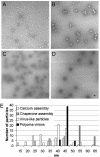Chaperone-mediated in vitro assembly of Polyomavirus capsids
- PMID: 12928495
- PMCID: PMC193586
- DOI: 10.1073/pnas.1832245100
Chaperone-mediated in vitro assembly of Polyomavirus capsids
Abstract
The polyomavirus coat protein viral protein 1 (VP1) has the intrinsic ability to self-assemble in vitro into polymorphic capsid-like structures on addition of calcium. In contrast, polyomavirus assembly in vivo is rigorously controlled, such that virions of uniform size are formed only in the cell nucleus. During viral infection, the 72 kDa cellular chaperone heat shock cognate protein (hsc70) binds VP1 posttranslation and colocalizes with VP1 to the nucleus, thereby suggesting a role for approximately 70-kDa heat shock protein (hsp70) family chaperones in regulating the quality and location of capsid assembly. We found that, after expression of recombinant VP1 in Escherichia coli, the prokaryotic hsp70 chaperone DnaK copurified with the VP1 C-terminal domain that links pentamers in an assembled capsid. When stably bound to VP1, DnaK inhibited in vitro assembly induced by calcium. However, in the presence of ATP, the hsp70 chaperone system comprised of DnaK, DnaJ, and GrpE assembled VP1 into uniform capsids without requiring calcium. Chaperone-mediated assembly was similarly catalyzed by the eukaryotic hsc70 protein, in combination with the J-domain function of the simian virus 40 large T-antigen protein. Thus, polyomavirus capsid assembly can be recapitulated with high-fidelity in vitro using either prokaryotic or eukaryotic hsp70 chaperone systems, thereby supporting a role for cellular chaperones in the in vivo regulation of virion assembly.
Figures





Similar articles
-
Chaperone-mediated in vitro disassembly of polyoma- and papillomaviruses.J Virol. 2006 May;80(10):5086-91. doi: 10.1128/JVI.80.10.5086-5091.2006. J Virol. 2006. PMID: 16641302 Free PMC article.
-
In vivo and in vitro association of hsc70 with polyomavirus capsid proteins.J Virol. 1995 Dec;69(12):7807-13. doi: 10.1128/JVI.69.12.7807-7813.1995. J Virol. 1995. PMID: 7494292 Free PMC article.
-
Effect of the DnaK chaperone on the conformational quality of JCV VP1 virus-like particles produced in Escherichia coli.Biotechnol Prog. 2014 May-Jun;30(3):744-8. doi: 10.1002/btpr.1879. Epub 2014 Mar 3. Biotechnol Prog. 2014. PMID: 24574306
-
Chaperone protein GrpE and the GroEL/GroES complex promote the correct folding of tobacco mosaic virus coat protein for ribonucleocapsid assembly in vivo.Arch Virol. 1998;143(11):2203-14. doi: 10.1007/s007050050452. Arch Virol. 1998. PMID: 9856102
-
Molecular chaperones and the process of cellular immortalization in vitro.Biogerontology. 2002;3(3):183-5. doi: 10.1023/a:1015603410174. Biogerontology. 2002. PMID: 12075137 Review.
Cited by
-
Stress proteins: the biological functions in virus infection, present and challenges for target-based antiviral drug development.Signal Transduct Target Ther. 2020 Jul 13;5(1):125. doi: 10.1038/s41392-020-00233-4. Signal Transduct Target Ther. 2020. PMID: 32661235 Free PMC article. Review.
-
Genetic analysis of the polyomavirus DnaJ domain.J Virol. 2005 Aug;79(15):9982-90. doi: 10.1128/JVI.79.15.9982-9990.2005. J Virol. 2005. PMID: 16014958 Free PMC article.
-
hsp72, a host determinant of measles virus neurovirulence.J Virol. 2006 Nov;80(22):11031-9. doi: 10.1128/JVI.01438-06. Epub 2006 Sep 13. J Virol. 2006. PMID: 16971451 Free PMC article.
-
The heat shock cognate protein 70 is associated with hepatitis C virus particles and modulates virus infectivity.Hepatology. 2009 Jun;49(6):1798-809. doi: 10.1002/hep.22852. Hepatology. 2009. PMID: 19434724 Free PMC article.
-
Evaluation of protective efficacy induced by virus-like particles containing a Trichinella spiralis excretory-secretory (ES) protein in mice.Parasit Vectors. 2016 Jul 4;9(1):384. doi: 10.1186/s13071-016-1662-7. Parasit Vectors. 2016. PMID: 27378450 Free PMC article.
References
-
- Liddington, R. C., Yan, Y., Moulai, J., Sahli, R., Benjamin, T. L. & Harrison, S. C. (1991) Nature 354, 278-284. - PubMed
-
- Griffith, J. P., Griffith, D. L., Rayment, I., Murakami, W. T. & Caspar, D. L. (1992) Nature 355, 652-654. - PubMed
-
- Garcea, R. L., Salunke, D. M. & Caspar, D. L. (1987) Nature 329, 86-87. - PubMed
Publication types
MeSH terms
Substances
Grants and funding
LinkOut - more resources
Full Text Sources
Other Literature Sources
Research Materials
Miscellaneous

